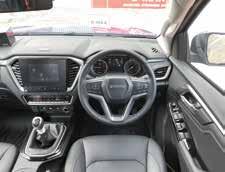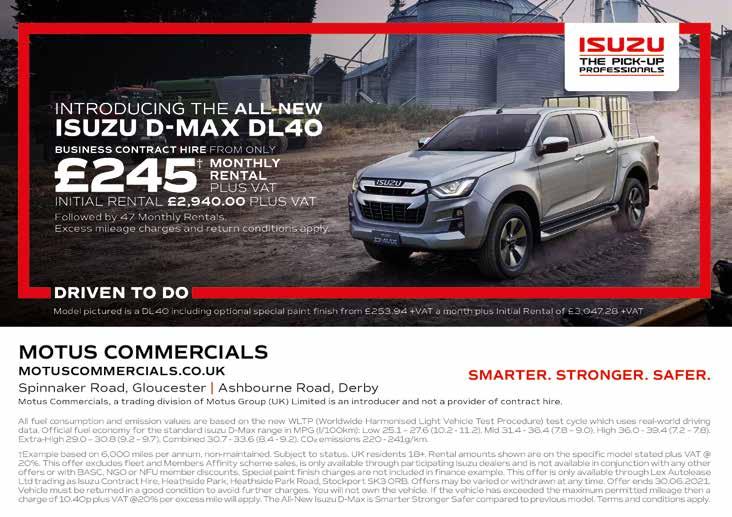
6 minute read
Isuzu D-Max V-Cross
Isuzu to the rescue of the lifestyle pick-up sector
As rivals have bailed out of the pick-up market, so Isuzu has invested heavily, giving its D-Max range a splash of urbane manners. Andrew Walker reports
Advertisement
What a great time to launch a new pick-up! Isuzu’s new D-Max has landed in the UK at exactly the right time for the Japanese brand. Established players Mitsubishi, Fiat Professional and Mercedes-Benz have left the sector altogether, Nissan has decided not to bring its latest Navara to the UK and VW is on a pick-up sabbatical, so the competition has shrunk.
To be fair to Isuzu, along with Toyota and Ford, the company has been one of the ‘Big Three’ pick-up manufacturers worldwide and as a commercial vehicle brand only, feels that it knows a thing or two about pick-ups.
Since the Isuzu D-Max launched in 2012, Isuzu has consistently grown sales volume, with a peak of over 6,000 units shifted in 2015. Sales volumes have stabilised at 5,000 a year since but with pre-sales of the all-new Isuzu D-Max so positive that demand is currently outstripping supply, Isuzu fully expects to easily meet its target of 5,000 registrations in 2021. Indeed, it is so optimistic it will sell well that it believes it can meet its original goal of 10,000 registrations well before the original target date of 2025.
The latest D-Max comes in three ranges: Business, All-Purpose and Adventure. These three are complemented by four trim levels: Utility, DL20, DL40 and V-Cross. CC&V had the opportunity to drive a number of new models at the UK launch and first up was the range-topping V-Cross model from the Adventure range. It’s an ideal place to start as it’s the model Isuzu believes will increase sales in the Adventure category by a third over the previous offerings.
The previous D-Max range-topper, the Blade, had a reputation for toughness, reliability and durability. What was slightly lacking, however, were the more car-like interiors, on-trend-tech and safety features you’d find on some of the competition. In the new version the former are still there – this is a pick-up that will go almost anywhere – but it now features some clever new additions that take it from a mountain bike to a gravel bike, which is a major improvement.
Engine and chassis
First and foremost, the 1.9-litre 162bhp engine carries over from the previous model. However, the ladder frame chassis, while similar to before, now comes with larger rails, additional bracing plus newer steels, all of which contribute to make it stronger. There’s a longer wheelbase, re-designed rear suspension, a shorter body but increased load space both inside and out and a newly designed front and rear end.
Also new is electric power-assisted steering, which makes a big difference both on and off road. The seats have also been redesigned and are now more comfortable, and the dashboard is more upmarket with a new touchscreen infotainment system. All models now come with a height and reachable adjustable steering wheel, steering wheel mounted audio and cruise controls, DAB radio, Bluetooth, a front USB port and a 4.2” multi-information display.
The D-Max load bed is 30mm deeper than it used to be, so Isuzu has put a step into the rear bumper to make reaching in easier. Every Double Cab model now gets a tailgate damper. And, thanks to Euro 6D emission standard, each model has a Selective Catalytic Reduction (SCR) system to reduce harmful Nitrogen Dioxide levels, so it has succumbed to AdBlue.
Payload
Every version has a payload rating of at least 1070kg, which is important for commercial vehicle tax purpose.There’s also a 3.5 tonnes towing capacity. Another interesting point is that every variant weighs under 2,040kg, meaning Extended and Double Cabs are subject to normal passenger car speed limits. Many double cab pick-up trucks – Ranger and Hilux included – exceed this weight limit so must comply with goods vehicle speed limits which are 10mph lower on single and dual carriageways. It’s a fact that many pick-up customers are unaware of.
Off-road: Will it get me through a forest?
Don’t worry, the latest D-Max is still perfect for anyone who needs to use their truck off road. The selectable shift-on-the-fly 4WD drive engages faster, rear axle articulation has increased and all models bar entry-level Utility models come with a mechanical rear diff lock in addition to electronic aids that now include hill descent control and hill start assist.
We tested it in a variety of situations. In water, it has a wading depth of 800mm; take it
through gravel and up and over some very steep hills and it performed admirably. The 4WD engages faster than before and the locking diff, low-range gearing and electronic aids work perfectly.
Safety
All double-cabs get a radar system, with Isuzu choosing to use stereo-imaging via a pair of cameras at the top of the windscreen enabling the AEB, lane keeping, traffic sign recognition and intelligent speed limiter to work more accurately than offered elsewhere. Plus, the new system enables cross traffic alert, blindspot monitoring and emergency lane keeping, all new to the pick-up sector. And if that’s not enough, Double Cabs get eight airbags, Single and Extended Cabs seven.
Emissions and fuel economy
Pick-up emissions and fuel economy are not a selling point. V-Cross manual offers 33.6 mpg/auto 30.7 mpg with emissions of 220g/km and 241g/km respectively.
V-Cross specifics
V-Cross certainly looks the part and features distinguishing ‘Gun Metal’ exterior styling on the radiator grille, side steps, door mirrors, door handles and 18” alloy wheels. It’s also very well equipped with heated front seats, rear parking sensors, Bi-LED headlights, LED front fog and an eight-way electrically adjustable driver’s seat. The 9” multifunction colour touchscreen is compatible with Apple CarPlay and Android Auto and comes with eight speakers, plus front and rear USB ports.
There’s also a dual-zone climate control system, an auto-dimming rear-view mirror and automatic headlight levelling. This is a pick-up tailored to the lifestyle sector.
What’s it like to drive?
One thing is for certain, and that is it’s light and day over the outgoing Blade to drive. The V-Cross handles the road much more like a large SUV than before, the electronic steering makes it easier to manoeuvre and the bigger brakes means it stops faster. The seats are way more comfortable and coupled with the improved body structure, there’s far less body-roll. Rear passengers get more leg room and the rear seats are angled to make the rear more comfortable as well. The improvement is impressive.
Any negatives?
The 1.9 engine works fine in almost every situation, but it’s lack of out-and-out pull could be an issue for some. The latest Hilux features a 2.8-litre engine with over 200bhp with 369 lb ft for example, while the D-Max only offers 164PS with 266 lb ft. It’s also a little sluggish compared to the Ford Ranger, taking 12.7 seconds to hit 62mph in the manual double cab and 13 seconds in the auto. In common with all pick-ups, there’s still some noticeably cheap plastics adorning the lower part of the dashboard, centre armrest and door pockets, even on the V-Cross.

CC&V VERDICT
This D-Max not only looks and drives better than before, it now features classleading safety, on-trend tech, a far better passenger experience and does most of what a pick-up is supposed to do. V-Cross is definitely a contender for those in the lifestyle pick-up sector
CC&V RATING:
N N N N











